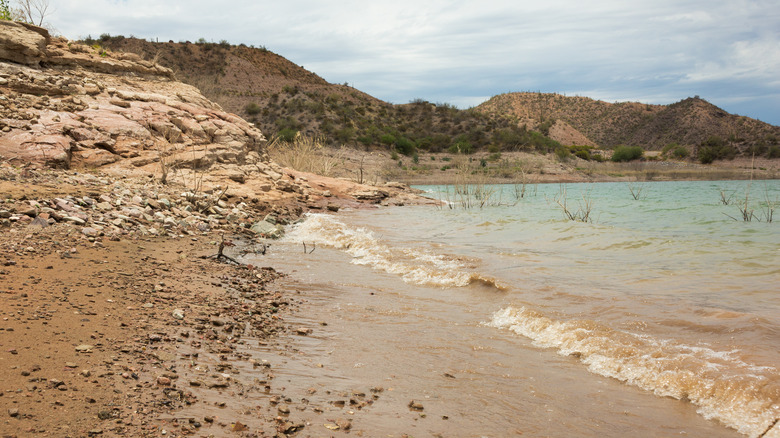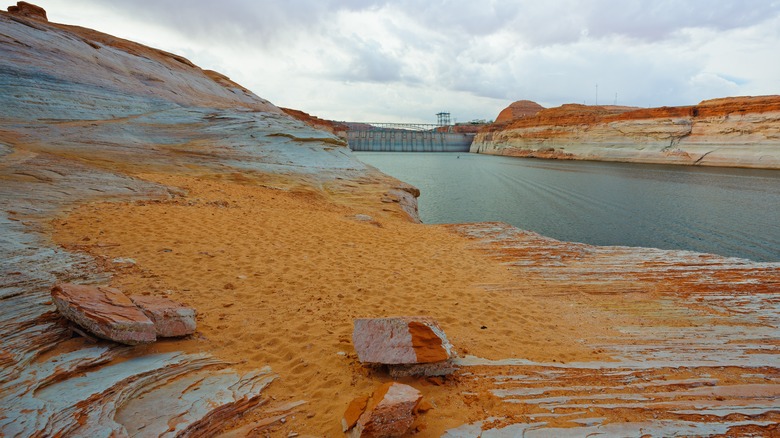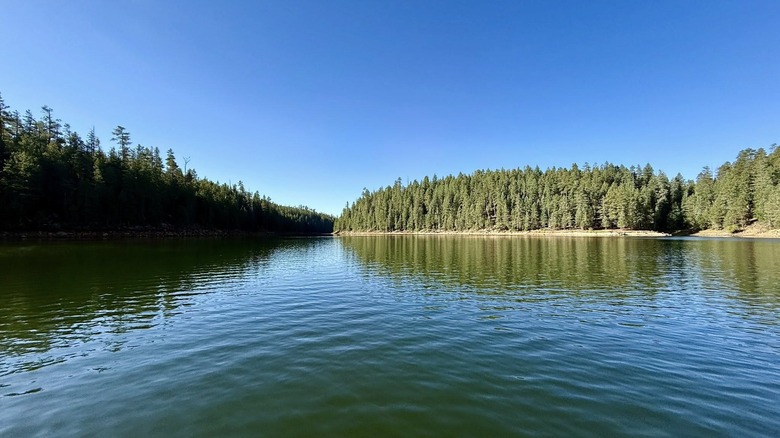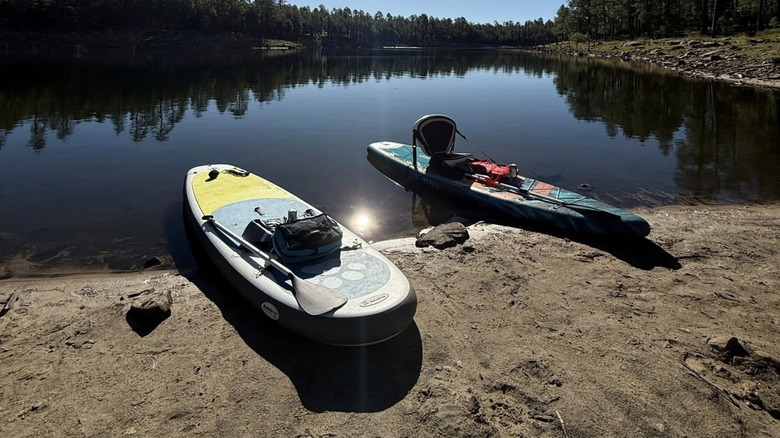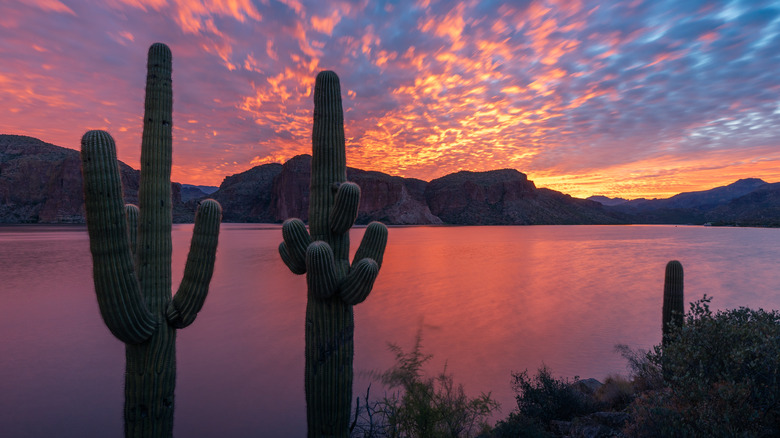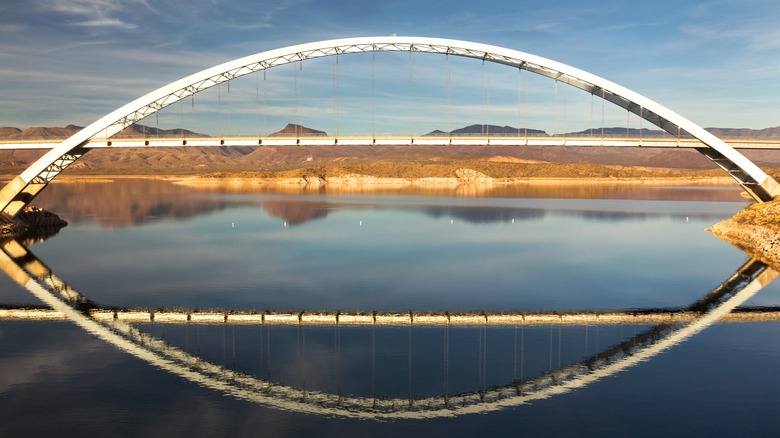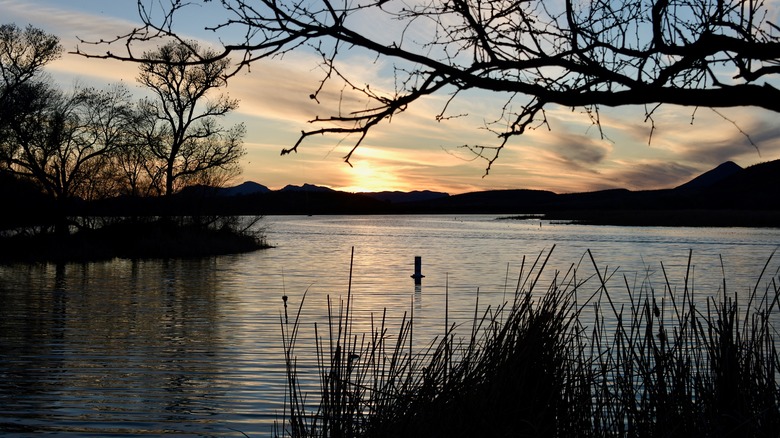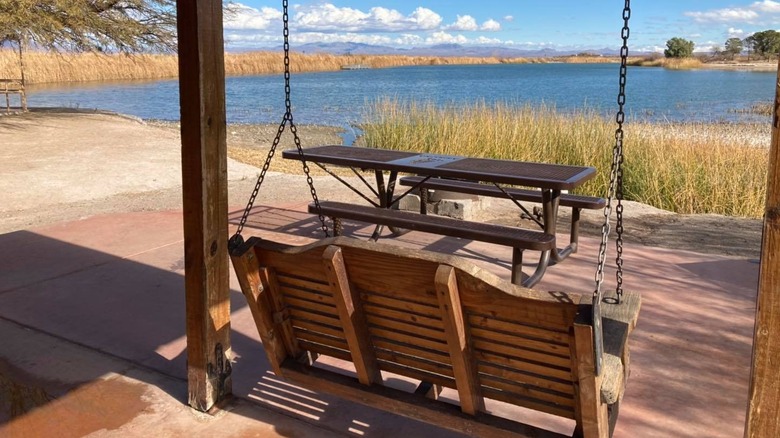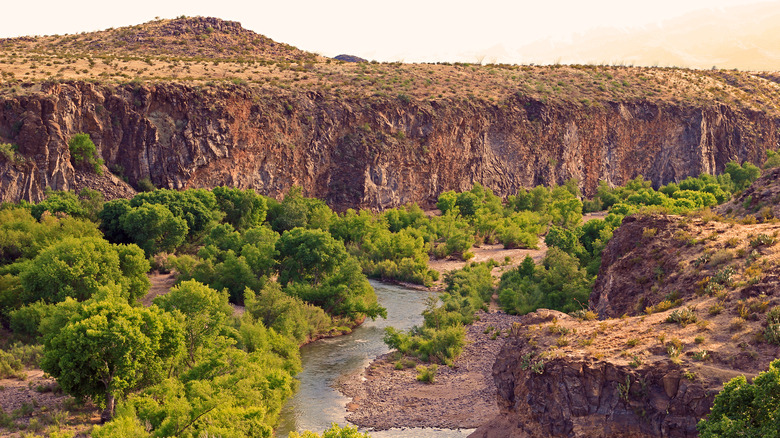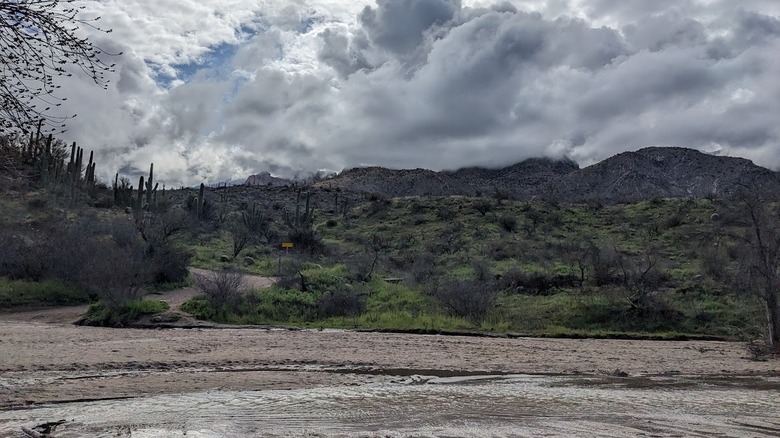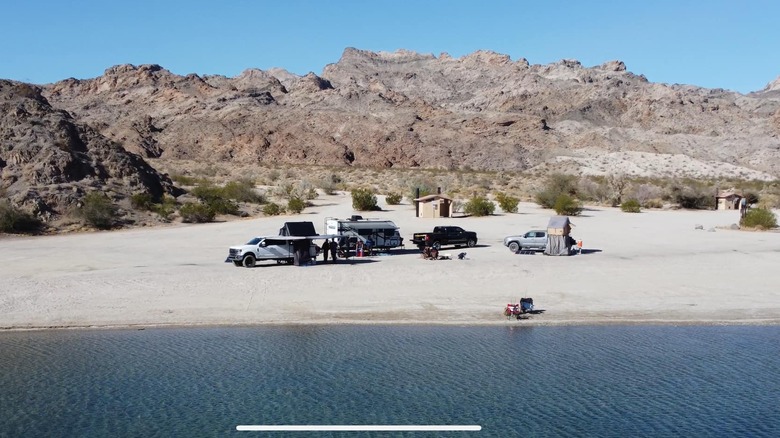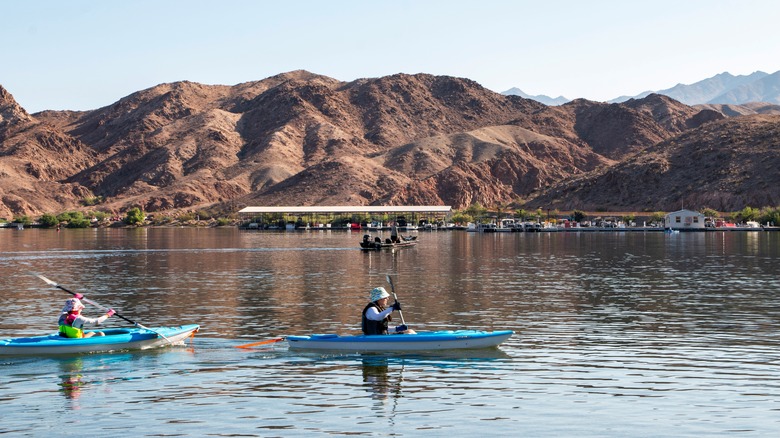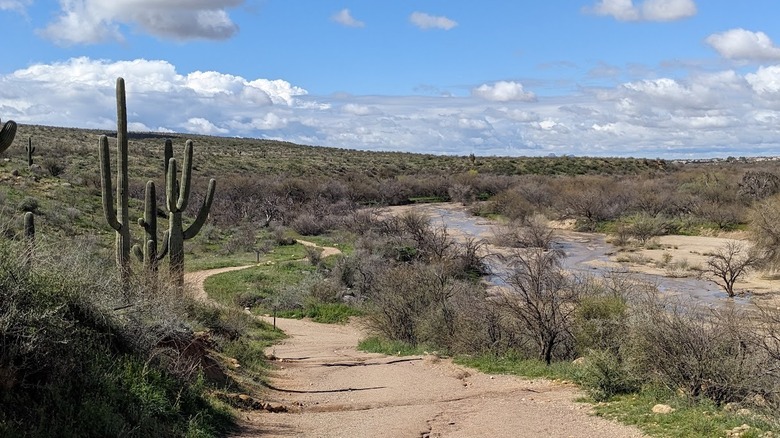The Best Beaches In Arizona That Aren't Too Crowded, According To Locals
Yes, Arizona is landlocked, and many people assume it's all desert. But the state actually offers a surprising variety of bodies of water — from natural alpine lakes to iconic reservoirs, and even little-known riparian gems. In fact, the entire western edge of Arizona is often nicknamed the state's "West Coast" thanks to its abundance of lakes, rivers, and reservoirs. The challenge? The most popular spots are often packed during the hot summer months, making it tough to find a place to cool off and relax. That's why, as a local, I turned to fellow Arizonans to uncover beaches across the state that have fewer crowds but plenty of adventure.
To make things easier, I've organized this list by geography since Arizona spans more than 113,000 square miles and is the sixth-largest state in America. Planning a trip to the Grand Canyon? Stick with Northern Arizona or venture into Rim Country. Heading to Phoenix? Check out our picks in Central Arizona. Visiting Tucson? Explore the beauty of Southern Arizona. And if you're road-tripping Route 66 for its 100th anniversary in 2026, Western Arizona is your best bet. Let's dive in.
The Chains at Lake Powell
Lake Powell could fill an entire story on its own. With nearly 2,000 miles of shoreline, it's the second largest reservoir in the country, just behind nearby Lake Mead. This recreation hot spot is iconic — and crowded all summer long. The good news is, with so much shoreline, you can still find pockets of solitude. In fact, the National Park Service notes there are nearly 100 side canyons to explore. One spot the Page Lake Powell Tourism Bureau recommends is an area called the Chains, and you don't even need a boat to get there. The name comes from the line of buoys that keep boats away from Glen Canyon Dam.
The trailhead for the Chains is about 10 minutes from Page, Arizona. Just head north on Lake Powell Boulevard to U.S. Highway 89 and turn left on the unpaved Chains Road. The road is rough but doesn't require four-wheel drive; however, if a monsoon storm has hit the area, you may find the road is washed out.
Park at the trailhead and head out on the 15-minute hike to the shoreline. Pack plenty of water, wear sturdy shoes for the rocky trail, and bring water shoes. Depending on current lake levels, you may find a sandy beach or just smooth rock ledges. You can enjoy this visit in just an hour, or stay all day. Locals recommend visiting on Wednesdays or Thursdays, especially in late summer when school is back in for a quieter visit.
Bear Canyon Lake's quiet coves
If you don't mind a bit of effort in exchange for solitude, locals will tell you Bear Canyon Lake is worth every step. Tucked into the high country of Arizona's White Mountains at 7,560 feet above sea level, this alpine canyon lake feels like a hidden blue gem surrounded by green ponderosa pines. You'll hike down to the water with your gear, which is part of the adventure, but also keeps crowds thinner than at nearby Woods Canyon Lake. On the water, you'll spot fishermen casting for rainbow trout, which the Arizona Game and Fish Department releases several times a year.
Paddleboarders also favor this lake, noting quiet coves where you can pull onto the shore to rest and have a snack. There are three ways to access the lake: Straight down from the parking lot, near the dam, or from the southern end. Whichever route you choose, just remember you'll have to carry everything back up. Bring plenty of water and sturdy shoes — the shoreline is sandy, but there are also plenty of flat rocks perfect for sitting and soaking in the quiet. You may even spot bald eagles here as you stare up at the lush trees of the Apache-Sitgreaves National Forests. From Flagstaff, take I-40 east to Winslow. You'll travel about 2.5 hours along forest roads, including Northern Arizona's scenic Rim drive.
Sardine Point at Willow Springs Lake
At 7,600 feet, Willow Springs Lake is another cool retreat in the White Mountains surrounded by pine forests. This lake is just about 35 minutes southeast of Bear Canyon Lake if you find the hike to be too much. While much of the edge is rugged, you can still find sandy stretches to spread out a blanket or launch a paddleboard. The lake is known for its breathtaking views and cliff-jumping spots, and is regularly stocked with trout by the Arizona Game and Fish Department, making it a popular destination for anglers. It's a sight to see when the truck pulls up to release the fish right into the lake.
Boaters will find a launch ramp near the main parking lot, while paddlers often head to Sardine Point Day Use Area. This peninsula, surrounded by water on three sides, is a favorite place to slip in a kayak or paddleboard and then drift into the lake's quiet coves. The beaches aren't named, so spend time exploring; you'll likely want to stay all day.
If you prefer to camp to get an early start on the water, check out nearby Sinkhole Campground and make reservations on Recreation.gov for just $33 at the time of this writing. There are also some first-come, first-served sites. The lake itself has no charge. From Payson, take State Route 260 east; the drive takes under 40 minutes, more if you pull over for the sweeping views of the forest.
Scenic Beach at Canyon Lake
Tucked in the Tonto National Forest east of Phoenix, Canyon Lake is my coworker's favorite. The 900-acre lake is fed by the Salt River, a vital source of water for Phoenix and Central Arizona. Getting here feels like an adventure in itself, with a winding two-lane road, complete with two one-lane bridges and sweeping views of the saguaro cacti, the lake, and the desert surrounding it.
The lake fills quickly with boats in the warmer months as people escape the heat, but you can head to the east end for a quieter stretch of shore. Keep an eye on the shoreline while you're on the water — spotting desert bighorn sheep is a highlight here. Launch a kayak or stand-up paddleboard from the Boulder Recreation parking lot, or relax on the sandy shoreline at Canyon Lake Scenic Beach in the Acacia Recreation Site. There's plenty of parking here, so you can grab a spot, set up an umbrella, and stay all day.
To enjoy Canyon Lake, you'll need a Tonto Daily Pass ($8 at the time of this writing), and if you want to launch a boat, you'll also need a watercraft sticker, which costs $4. From Phoenix, take U.S. 60 east to Apache Junction, then follow State Route 88 (Apache Trail) northeast for about 15 miles. The drive takes roughly an hour. While you're in the area, plan to stop at Tortilla Flat, Arizona's last stagecoach town. It's just three miles from the lake and is known for its prickly pear ice cream.
Bermuda Flat Shoreline at Roosevelt Lake
Another 30 miles beyond Canyon Lake, the Salt River winds toward Roosevelt Lake, a place that feels both expansive and tucked away at the same time. This reservoir, created by Theodore Roosevelt Dam, is the largest lake entirely located in Arizona. One of its most striking landmarks is the Theodore Roosevelt Lake Bridge, a steel-arch span rising roughly 300 feet above the water. It's the longest two-lane, single-span steel-arch bridge in North America and is painted light blue to blend in with the stunning, wide-open sky.
For a true lakeside escape, locals suggest camping at Bermuda Flat Shoreline, where first-come, first-served sites let you pitch your tent right at the water's edge. There are miles of shoreline here to choose from, with mesquite trees offering additional shade. Facilities are minimal, so pack in everything you need and plan for a weekday visit to avoid weekend crowds. Day-use or camping fees apply: $8 per vehicle per night for the Forest Service area, with boating requiring the same Tonto Daily Pass as Canyon Lake. With miles of shoreline and wide-open views, Roosevelt Lake offers a larger, more spacious counterpart to Canyon Lake, perfect for boating, fishing, and quiet reflection.
Patagonia Lake's east side
My friend Amanda is an avid traveler, so when I spotted her Facebook post about Patagonia Lake, I had to ask if it was worth including in this article. My past visits weren't ideal — loud music and limited spots along the shoreline made it hard to relax — but I'm happy to find out that things have changed in recent years. Arizona State Parks now implements weekend midday closures when the lake reaches capacity, to help mitigate crowds. There are also brand-new cabins available to rent, letting you walk right to the beach and enjoy the water. When I checked out availability, I was surprised to find reservations available for Labor Day weekend at just $129 a night, so it appears this is a hidden gem. Rent or bring your kayak, paddleboard, or canoe to enjoy the water. You may also be surprised to discover that water skiing is allowed on this 265-acre lake.
Amanda gave three tips: visit on a weekday, head to the east side of the lake, which is a no-wake zone, and "Definitely go early in the day, or in the early evening, and you will see birds and coatis (an adorable raccoon-like animal with long, ringed tails)." In fact, this desert oasis, just an hour and 15 minutes south of downtown Tucson, is a haven for wildlife. With more than 70 species here, birdwatchers can spot quail, curve-billed thrashers, and several species of hummingbirds. Be sure to check out the town of Patagonia, just 20 minutes away. The quaint spot is Arizona's best-kept secret, brimming with trails, art, and wineries.
Roper Lake's cabins or campsites
Located near Safford, Arizona, Roper Lake State Park is packed with scenic camping sites and recreation. It's perfect for visitors looking to unplug and enjoy nature. With no Wi-Fi, lakeside cabins, and campsites right on the swim beach, it's ideal for a secluded retreat. Visitors can enjoy hiking, fishing, boating, or birdwatching, with plenty of space to spread out along the shore and relax. Anglers can fish for largemouth bass, crappie, sunfish, channel catfish, and rainbow trout, which are stocked seasonally by the Arizona Game and Fish Department. The park also provides a boat ramp for small electric or nonmotorized vessels, and five miles of trails offer opportunities for hiking and spotting wildlife. Several of my friends noted you shouldn't leave any food out at night while camping here, unless you want raccoons to visit.
For an even quieter experience, a short drive away is Dankworth Pond State Park. This smaller pond features a fishing pier near the park entrance. You can also explore a re-created Native American village on the Dos Arroyos Trail loop. Both parks reward early-morning visitors with peaceful water views and abundant wildlife. You actually get access to both spots with one entrance fee of $20 per vehicle, $10 if you're solo. From Safford, take U.S. 191 south for approximately five miles.
Explore Gila Box
Spanning 23,000 acres in remote southeastern Arizona, Gila Box is a hidden desert oasis carved by the Gila River. With tall cottonwood trees providing shade, mountains and saguaros at every turn, and refreshing, flowing water, this is a spot where you can float, swim, or just relax along the riverbanks. In the spring, snowmelt swells the river for kayaking, canoeing, and rafting adventures, while the calmer summer months are perfect for a lazy float. With green, shady riverbanks, flowing water deep enough to fully immerse yourself, and the chance to explore small coves and riparian beaches, Gila Box is a quiet, refreshing escape for those looking to beat the crowds.
Locals recommend starting your adventure at the beach at the Shores Site Campground just north of Winkelman, about an hour and 20 minutes from Tucson. Bonita Creek, a serene tributary, is ideal for picnicking and wildlife spotting. Keep an eye out for desert bighorn sheep navigating the cliffs. Since this area is in Bureau of Land Management (BLM) jurisdiction, dogs are allowed here, making it a perfect day trip for the whole family. From Tucson, take State Route 77 north toward Winkelman. Follow signs to Shores Site Campground, East Wetlands, or West Wetlands, depending on your desired access point.
Catalina State Park's seasonal washes
I couldn't resist adding my favorite beach to this list. Just north of Tucson, the 5,500-acre Catalina State Park transforms into a desert oasis after summer or winter rains. While not a traditional sandy beach, the washes create shallow pools and gentle streams that are perfect for wading, splashing, or simply relaxing by the water. I've watched families bring buckets and shovels so kids can dig and play. The banks make natural "sunning spots" for picnics or just dipping your toes. Try the 2.3-mile (one way) Canyon Loop Trail, which features several water crossings at low elevation — giving you a hike with built-in splash breaks. Then, head toward Sutherland Wash near the trailhead. The flowing creek often pools into deeper pockets that feel like mini swimming holes tucked in the desert. Bring water shoes or sandals with straps — they make it much easier to cross the streams while hiking.
Surrounded by thousands of saguaros and bursts of wildflowers in season, the setting feels uniquely Arizona. Even though it's just 15 miles north of downtown Tucson, it feels like a world away. Early mornings and late afternoons are the best times to visit, both for cooler temperatures and for spotting wildlife like deer, javelinas, and colorful desert birds. The park is also dog-friendly, so you may spot pups bounding through the water right alongside their owners. This park is also $20 per vehicle at the time of this writing, $10 for solo travelers.
Lake Mohave's Telephone Cove
For a peaceful retreat along the Colorado River, Telephone Cove offers two sandy beaches on the Arizona side of Lake Mohave: North Cove and South Cove. Unlike the busier Lake Havasu, this spot stays quieter, even on weekends, making it a favorite for locals and paddlers looking for solitude. The sand is soft, the water is clear, and the surrounding desert landscape provides a dramatic backdrop of cliffs and cacti. This area is the recommendation of my former coworker Nicole, who lives in Bullhead City and is now working in tourism there.
Paddleboarders and kayakers love Telephone Cove because the calm waters allow for easy exploration of the shoreline, small inlets, and coves. Anglers also find success here; largemouth bass, striped bass, and catfish are common catches. Swimming is safe near the beaches, but as always, take caution in deeper areas and bring flotation devices. There are no concession stands, so pack snacks, water, and shade. Picnic tables are available near the parking areas, and restrooms are minimal, so plan ahead. For those seeking a longer adventure, the two beaches are connected by a short drive and accessible by water, so you can paddle between them for a mini-lake tour.
From Bullhead City, drive north on U.S. 95 to Katherine Landing, then follow signs for Lake Mohave and Telephone Cove. Both North and South beaches are accessible by car, with parking right near the water. A short hike from the parking area leads directly to the shoreline, making it easy to carry gear for kayaking or a picnic. Bring binoculars as desert bighorn sheep and a variety of birds have been spotted along the cliffs and nearby shoreline.
Lake Mohave's Willow Beach
On the same water, about 90 minutes away, there is another beach worth mentioning on Lake Mohave: Willow Beach. This spot sits at the northern tip of the lake, just across from Henderson, Nevada, but firmly on the Arizona side. This area is a paddler's paradise, offering calm waters and access to hidden coves and quiet beaches. One of the highlights is Emerald Cove (also called Emerald Cave), where the water shimmers a deep emerald green when the sunlight hits just right, perfect for photos or a relaxing float. Early morning or late afternoon paddles not only reduce crowds but also offer the best chance to see wildlife and enjoy the desert light as it hits the water. Bring water shoes; the shoreline can be rocky in spots, and shade is limited.
The launch area is well-maintained, with parking and picnic tables available for a riverside lunch. Restrooms are limited, so plan accordingly. Willow Beach works well for a day trip, a quiet paddle, or even a short camping excursion at nearby facilities. For those seeking solitude, paddling upriver or exploring side coves will lead to some of the quietest stretches of the Colorado River in Arizona. From Bullhead City, take U.S. 95 or U.S. 93 north. The main parking area and boat launch are clearly marked. If you're coming from Las Vegas, take U.S. 95 south, cross into Arizona via the Hoover Dam Bypass, and follow signs to Willow Beach.
Methodology
Arizona's beaches may not be oceanfront, but they provide alpine escapes, desert coves, and riparian surprises — all with fewer crowds if you know where to look. To build this list, I combined personal experience with community insights. The initial ideas came from my own explorations and favorite spots, then I expanded through recommendations gathered from friends and former coworkers.
I also tapped into the Arizona Paddleboard and Kayaking group on Facebook, a community known for detailed advice on hidden coves, launch sites, and paddling routes. Cross-referencing these tips with state park resources and recreation maps helped me finalize the list above.
